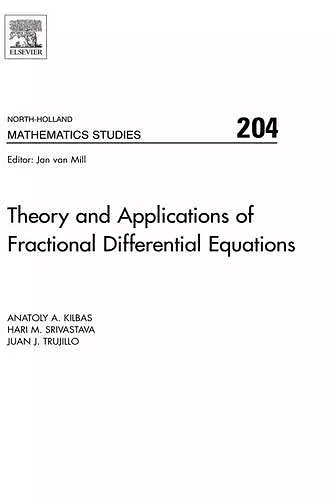Theory and Applications of Fractional Differential Equations
Hari M Srivastava author AA Kilbas author JJ Trujillo author
Format:Hardback
Publisher:Elsevier Science & Technology
Published:12th Jan '06
Currently unavailable, and unfortunately no date known when it will be back

This monograph provides the most recent and up-to-date developments on fractional differential and fractional integro-differential equations involving many different potentially useful operators of fractional calculus.The subject of fractional calculus and its applications (that is, calculus of integrals and derivatives of any arbitrary real or complex order) has gained considerable popularity and importance during the past three decades or so, due mainly to its demonstrated applications in numerous seemingly diverse and widespread fields of science and engineering.Some of the areas of present-day applications of fractional models include Fluid Flow, Solute Transport or Dynamical Processes in Self-Similar and Porous Structures, Diffusive Transport akin to Diffusion, Material Viscoelastic Theory, Electromagnetic Theory, Dynamics of Earthquakes, Control Theory of Dynamical Systems, Optics and Signal Processing, Bio-Sciences, Economics, Geology, Astrophysics, Probability and Statistics, Chemical Physics, and so on.In the above-mentioned areas, there are phenomena with estrange kinetics which have a microscopic complex behaviour, and their macroscopic dynamics can not be characterized by classical derivative models.The fractional modelling is an emergent tool which use fractional differential equations including derivatives of fractional order, that is, we can speak about a derivative of order 1/3, or square root of 2, and so on. Some of such fractional models can have solutions which are non-differentiable but continuous functions, such as Weierstrass type functions. Such kinds of properties are, obviously, impossible for the ordinary models.What are the useful properties of these fractional operators which help in the modelling of so many anomalous processes? From the point of view of the authors and from known experimental results, most of the processes associated with complex systems have non-local dynamics involving long-memory in time, and the fractional integral and fractional derivative operators do have some of those characteristics.This book is written primarily for the graduate students and researchers in many different disciplines in the mathematical, physical, engineering and so many others sciences, who are interested not only in learning about the various mathematical tools and techniques used in the theory and widespread applications of fractional differential equations, but also in further investigations which emerge naturally from (or which are motivated substantially by) the physical situations modelled mathematically in the book.This monograph consists of a total of eight chapters and a very extensive bibliography. The main objective of it is...
"This book presents a nice and systematic treatment of the theory and applications of fractional differential equations." --ZENTRALBLATT MATH DATABASE 1931-2007"This book is a valuable resource for any worker in electronic structure theory, both for its insight into the utility of a variety of relativistic methods, and for its assessment of the contribution of relativity to a wide range of experimental properties." --THEOR CHEM ACC (2007)"For obvious reasons, the book is rather technical, but its main goal is the ultimate applications. These are explicitly or implicitly present during the whole text but they are only treated in their mathematical formulation. I.e., the electrotechnical, biological, optical, or whatever exotic context it could have been embedded in is avoided here. The book is thus certainly interesting for the (applied) mathematician, but, also for researchers who are working in one of the quite diverse applied areas where fractional models are more and more used these days." --Bulletin of the Belgian Mathematical Society
ISBN: 9780444518323
Dimensions: unknown
Weight: 1110g
540 pages